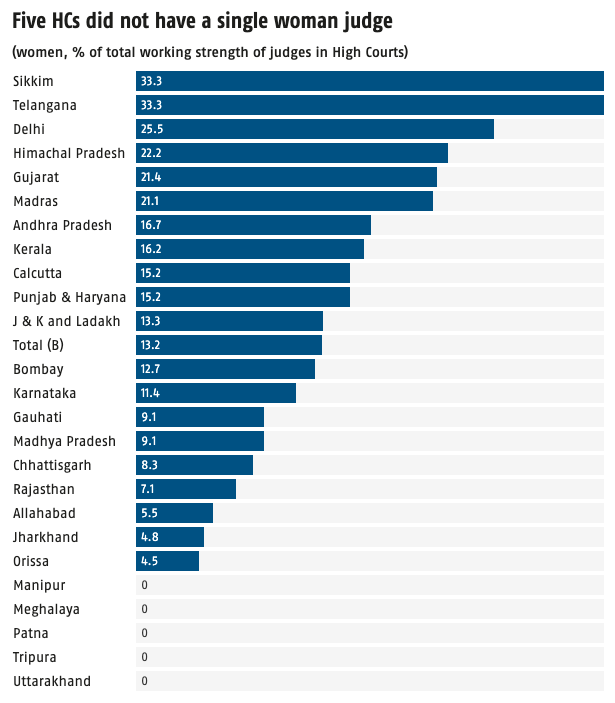Contents
| For 7PM Editorial Archives click HERE → |
Introduction
The Supreme Court has constituted an all-women bench to hear petitions involving matrimonial disputes and bail matters. This is only the third occasion in the history of the Supreme Court that an all-women bench has been constituted. The earlier two occasions were in 2013 and in 2018. The Supreme Court hasn’t had a Woman Chief Justice since its inception. Justice B V Nagarathna is expected to become the first Women Chief Justice in 2027. At present, of the 27 Judges (against sanctioned 34) of the Supreme Court, only 3 are women. This indicates the skewed representation of women in Judiciary. The disparity is not limited to Supreme Court, but is pervasive at all levels of the Judiciary. There are several institutional and structural factors that has limited women’s representation in Judiciary. Addressing this disparity is essential to ensure equitable access to justice.
What is the Status of Representation of Women in Judiciary?
Supreme Court: There are 3 Women Judges out of 27 Judges (including the CJI) at present. The proportion is 11%. There have been only 11 women Judges in the history of Supreme Court so far. Of them, 6 have been appointed since 2014 and 5 since 2018.
High Courts: Collectively for all High Courts, Women Judges constitute only 13.2% of the Judges. However, there are considerable variations among High Courts (HCs). 5 HCs have not a single women Judge. Another 7 HCs have < 10% Women Judges. Sikkim and Telangana HCs have highest representation at 33.3%.
Source: Business Standard
Lower Judiciary: Women Judges constitute ~35% of the Judges in the lower courts. Here the proportion varies from 19.5% in Gujarat to 70% in Goa. 17 of the 36 States and UTs had a smaller proportion of women in the lower judiciary than the national average.
Based on Government’s reply in the Lok Sabha in July 2022.
Out of 1.7 million advocates in the country only 15% are women. Only 2% elected representatives in the State Bar Councils are women.
What are the reasons for Low Representation of Women in Judiciary?
Judicial Rules: Article 233 puts the condition of 7 years of practice as an advocate to be eligible for appointment as District Judge. The Judiciary has interpreted this as 7 years of continuous practice. Most States’ Judicial rules dictate a minimum age of 35 years for entry as a district judge through direct recruitment. No one below the age of 55 years can be appointed as a judge in the Supreme Court. Marriage and Family responsibilities in this age group reduces the ability of women to compete for roles in the Judiciary.
‘Leaking Pipeline’ Syndrome: The leaking pipeline syndrome is often used as a metaphor for the way women disappear as they move from lower to higher levels. The phenomenon of the leaking pipeline is witnessed across a spectrum of careers including the Judiciary (~35% Judges in Lower Courts to ~11% in the SC). Family responsibilities, personal choices, long working hours and work-life conflict, working conditions, lack of access to employment opportunities, barriers to advancement, inadequate support from family results in women frequently dropping out mid-career. This ‘voluntary withdrawal’ masks the tacit consent given to patriarchally prescribed gender roles.
Opaque Recruitment Process (Collegium System): There are comparatively more women in the lower tiers of Judiciary due to the presence of formal qualifications and examinations. Such arrangement is more rational and transparent. Appointments to Higher Judiciary are undertaken through opaque Collegium System where the eligibility and selection criteria are not known. Critics of collegium system say appointment depends upon favourable evaluations and professional/personal networks.
Uncomfortable Environment: The environment is hostile and sexist making it difficult for female litigators to grow as professionals. According to a Research Paper ‘Structural and Discretionary Bias: Appointment of Women Judges in India’ 13 Judges out of 19 interviewed acknowledged the gender bias that exists in the appointment procedure of Judges to the Supreme Court and the High Courts.
Lack of Supportive Infrastructure: The dearth of supportive provisions and infrastructure, from toilets to maternity leave, also contribute to a high attrition rate amongst women lawyers. In 6,000 courts across the country, 22% of them do not have separate toilets for women. Many women law graduates prefer to join corporate sector.
Lack of Enabling Provisions: While quotas for women have been implemented in the lower courts of many states, these policies are yet to be implemented in the Higher Judiciary. States like Assam, Rajasthan, Andhra Pradesh, Telangana, Odisha have these enabling provisions and have > 40% Women Judges.
What are the impacts of Low representation of Women in Judiciary?
Prejudice in Judgements: Critics argue that lack of gender perspective leads to prejudiced Judgments e.g., In August 2020, the High Court of Madhya Pradesh granted bail to a molester on the condition that he will get a rakhi tied by the victim. Sometimes Judgments tend to uphold the “behavioural ethics” of Indian women (i.e., how ideal women should behave) e.g., in June 2020, while granting bail to a rape accused, the Karnataka High Court observed that the “after-rape behaviour of the victim is not how a rape victim ‘ideally behaves’“. The basis of such judgements is limited to the ideal dignity of a woman, and not on the criminal nature of the act itself.
Deficiencies in Legal Reasoning: The ability of the legal system to understand and respond to different social circumstances and experiences is enriched by more judicial diversity. If there is not adequate women’s representation, the justice system will not be able to meet the needs of women and other underserved communities.
Trust Deficit: The lack of women representatives in courts give rise to questions about the courts’ legitimacy as representatives of the societies they serve.
What should be the approach going ahead?
Gender Sensitisation: Certain issues need personalization by the Judges. They must see themselves in the shoes of the victim while dealing with cases of sexual violence. The CJI Justice Chandrachud recently remarked that Feminist approach should be imbibed while dealing with law. All India Bar Examination should contain questions or sections relating to gender sensitisation.
Gender Bias Task Forces: Similar to the Gender Bias Task Forces in the US, which look at how gender affects court systems, India needs a committee that works to make the judiciary more open to everyone (International Association of Women Judges, 2019).
Mentorship System: The Geneva Forum on Women in the Judiciary (2013) had suggested a mentorship system where senior women judges and lawyers can help and guide their younger peers. Regular, informal meetings of women judges and lawyers can be a great way for them to talk about the challenges they faced and figure out what kind of help they need. Such arrangements will prompt more young women to join the judiciary.
Moulding the Rules: The Court have to be cognizant of the societal and familial pressures women face and have to mould their rules accordingly so that more women take up or to continue court practice even after marriage. Lowering the minimum age requirement for the appointment of a district judge can stop female advocates from opting out of practice and working in the corporate sector. Conducive environments and adequate opportunities should be created for women to flourish as advocates and Judges.
Enabling Provisions: Former CJI Justice Ramanna had exhorted women lawyers to strongly raise their demand for 50% reservation in the judiciary. The Supreme Court should ponder on gradually improving the ratio of women Judges in higher Judiciary. Presence of Women Judges can have a revolutionary impact on jurisprudence e.g., Justice Sujata Manohar (2nd Women Judge to be appointed to the Supreme Court) was responsible for writing up the Vishakha guidelines.
Conclusion
The representation of women in the Judiciary has seen a gradual uptick. However, despite recent improvements, women continue to face bias in the judicial field. Both institutional mechanisms and social change are necessary to overcome the bias and make the Judiciary truly representative.
Syllabus: GS I, Social Empowerment; GS II, Structure, organization and functioning of the Executive and the Judiciary.
Source: The Hindu, Business Standard, Business Standard, The Georgetown Journal of Gender and the Law
Discover more from Free UPSC IAS Preparation Syllabus and Materials For Aspirants
Subscribe to get the latest posts sent to your email.









